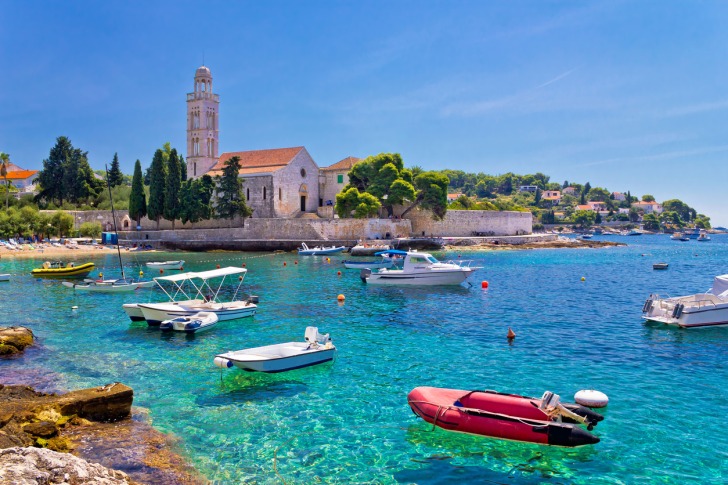Situated amongst the sun-drenched shores of the Adriatic Sea, Croatia offers a coastline dotted with picturesque towns and islands, each offering charm, cultural gems, and their own particular qualities.
Amongst these alluring locations, on the Dalmatian coast, lie the historic city of Split and the idyllic island of Hvar.
Both these destinations beckon travelers with their rich history, stunning landscapes, and vibrant culture.
Let’s look at the unmissable attractions of each location – but first, what is the best way to travel from Split to Hvar?
As Hvar is an island without an airport, the only way to get there from the Croatian mainland is by ferry.
Four operating companies offer the service, so in high season there are up to twenty ferries per day to choose from.
However, only two or three ferries depart daily during the low season.
Then again, a trip in September or October is wonderfully temperate, with average daily thermometer readings between 22 and 17 degrees Celsius (72 – 62F).
During that quiet season, many Americans are found as digital nomads on the island, renting cheap apartments to work in the wonderful climate and peaceful locations.
In fact, during the 2020 pandemic, Croatia opened up its borders to US visitors when many European countries did not.
The 23-mile (37 km) journey takes between 55 minutes and two-and-a-half hours, depending on which mode of water transport you choose.
The price range of service availabilities is extremely wide; from just $7 USD to over $250 per person.
The cheapest service is simply by foot passage on the catamaran ferry, but a party of up to eight people can be collected by private shuttle bus from Split airport (SPU) and delivered directly to their Hvar Island for around $180 per passenger.
The most expensive service is a swish speedboat ferry, which can set you back up to $230 per person.
Hanging Out in Hvar
Hvar is known for its yacht parties and watersports, and the water is warm enough in high season not to need a wetsuit – at least for short dips near the coast.
Average sea temperatures in August are usually around 25C (77F)
Situated between the islands of Brač, Vis, and Korčula, at around 42 miles long with 168 miles of coastline, the island of Hvar boasts a 2000-foot mountain at its peak, Sveti Nikola – a mecca for hikers and fit outdoorsy people.
The views on the way to the summit are breathtaking.
For the rockhounds, Hvar hosts a large fertile coastal plain with freshwater springs, backed by a Mesozoic limestone and a dolomite ridge.
The slopes are covered in pine forests, with olive groves, vineyards, fruit orchards, and lavender plantations.
Hvar Town is set around a stunning harbor, where yachts are moored facing a Mediterranean backdrop of brightly painted Venetian buildings.
Hvar Fortress is perched on top of a hill overlooking the town.
The ancient stone steps to the summit afford wonderful views of the azure sea and the rugged coastline below.
The fortress itself is fascinating.
If only those medieval walls and towers could talk, they’d tell of their construction back in 1278AD, and the repelling of the Turks during the siege in 1571.
The winding streets of Hvar Town are a warren of hidden squares, boutique shops, and charming cafes.
The promenade of Riva is a delight to patronize for a long lazy lunch, sipping a cold glass of Graševina wine while watching the boats bobbing in the harbor.
Hvar’s coastline offers secluded coves and pristine beaches; even its own islands -such as the Pakleni mini-archipelago, 16 islets covering 5 square miles interspersed by crystal-clear paradisiacal lagoons.
Split – Steeped in History
The ancient Croatian city of Split is a UNESCO World Heritage Site renowned for its mixture of Roman ruins and medieval architecture.
Indeed, it is home to one of the world’s most impressive Roman monuments – the Diocletian’s Palace.
Built in the 4th century AD by the Roman emperor of that name, this sprawling palace complex oozes ancient Roman culture from the 4th Century AD when it was built.
Each of the four outer walls of the palace has a central gate named after a metal: gold, bronze, silver, and iron.
The Bronze Gate once opened straight from the harborside, allowing goods to be unloaded directly from ships.
Between the eastern and western gates, a straight road now known as Krešimirova (Roman name Decumanus) separated the emperor’s residence on the southern side from the northern side, once used as a barracks and servants’ quarters.
The palace itself has now disappeared, but the footings still survive as part of the demarcation of the city walls – now full of restaurants and shops.
The towering Cathedral of Saint Domnius, with its iconic bell tower, stands over Peristyle Square, where street performers entertain crowds amidst ancient columns.
Food, Culture, and Beaches
As regards dining out, Split offers a vibrant mix of cuisines, from street food to Michelin-starred restaurants.
Ultra-fresh seafood can be followed by mouth-watering pastries with aromatic dessert wines.
You might say that Split is a foodie heaven.
In summary, whether you’re a history buff, a nature lover, a sun-seeking backpacking beach bum, or even a party animal with a cultural streak, the Mediterranean paradise of the Dalmatian coast is a treat not to be missed.











